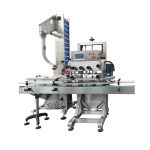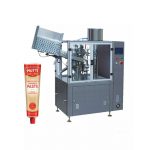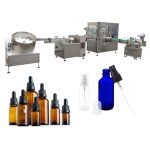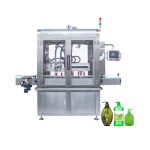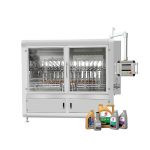A gravity filling machine is a type of liquid filling machine that uses the principle of gravity to accurately dispense and fill containers with liquid products. These machines are commonly used in the food and beverage, pharmaceutical, and personal care industries to package and distribute products such as sauces, dressings, juices, and lotions.

Gravity filling machines consist of a series of interconnected components that work together to dispense and fill containers with a specific volume of liquid. The main components of a gravity filling machine include:
- A hopper or tank that holds the liquid product
- A pump or gravity feed system that moves the liquid from the hopper to the filling nozzle
- A filling nozzle that dispenses the liquid into the container
- A filling volume control system that determines the exact amount of liquid to be dispensed
- A conveyor system that moves the containers through the filling process
- A capping and labeling system to seal and label the filled containers
To use a gravity filling machine, the operator first places the empty containers onto the conveyor system. The conveyor system then moves the containers through the filling process, stopping at the filling nozzle when it is time to dispense the liquid. The filling nozzle is designed to dispense a specific volume of liquid into each container, and this volume can be adjusted using the filling volume control system.
Once the desired volume of liquid has been dispensed, the conveyor system moves the filled container to the capping and labeling station. Here, the machine applies a cap or closure to the container and applies a label with product information such as the name, expiration date, and ingredients.
There are several advantages to using a gravity filling machine for liquid filling. One of the main benefits is that these machines are relatively simple and easy to operate. They do not require complex programming or specialized training, making them a good choice for smaller businesses or those with limited resources.
Another advantage of gravity filling machines is their accuracy and precision. These machines are designed to dispense a specific volume of liquid into each container, and this volume can be easily adjusted using the filling volume control system. This ensures that every container is filled with the same amount of product, which is important for quality control and consistent product appearance.
Gravity filling machines are also relatively inexpensive compared to other types of filling machines. They do not require complex mechanical systems or specialized parts, which keeps their cost down. Additionally, gravity filling machines are relatively low maintenance, as they do not have many moving parts that can wear out or break.
There are some limitations to using a gravity filling machine, however. These machines are best suited for low to medium viscosity liquids, as thicker liquids may not flow through the filling nozzle as easily. Additionally, gravity filling machines are not suitable for products that are prone to foaming or splashing, as this can lead to inaccurate filling and product waste.
In conclusion, a gravity filling machine is a type of liquid filling machine that uses the principle of gravity to accurately dispense and fill containers with liquid products. These machines are simple and easy to operate, accurate and precise, and relatively inexpensive. They are commonly used in the food and beverage, pharmaceutical, and personal care industries to package and distribute products such as sauces, dressings, juices, and lotions.






